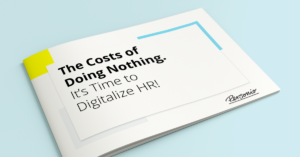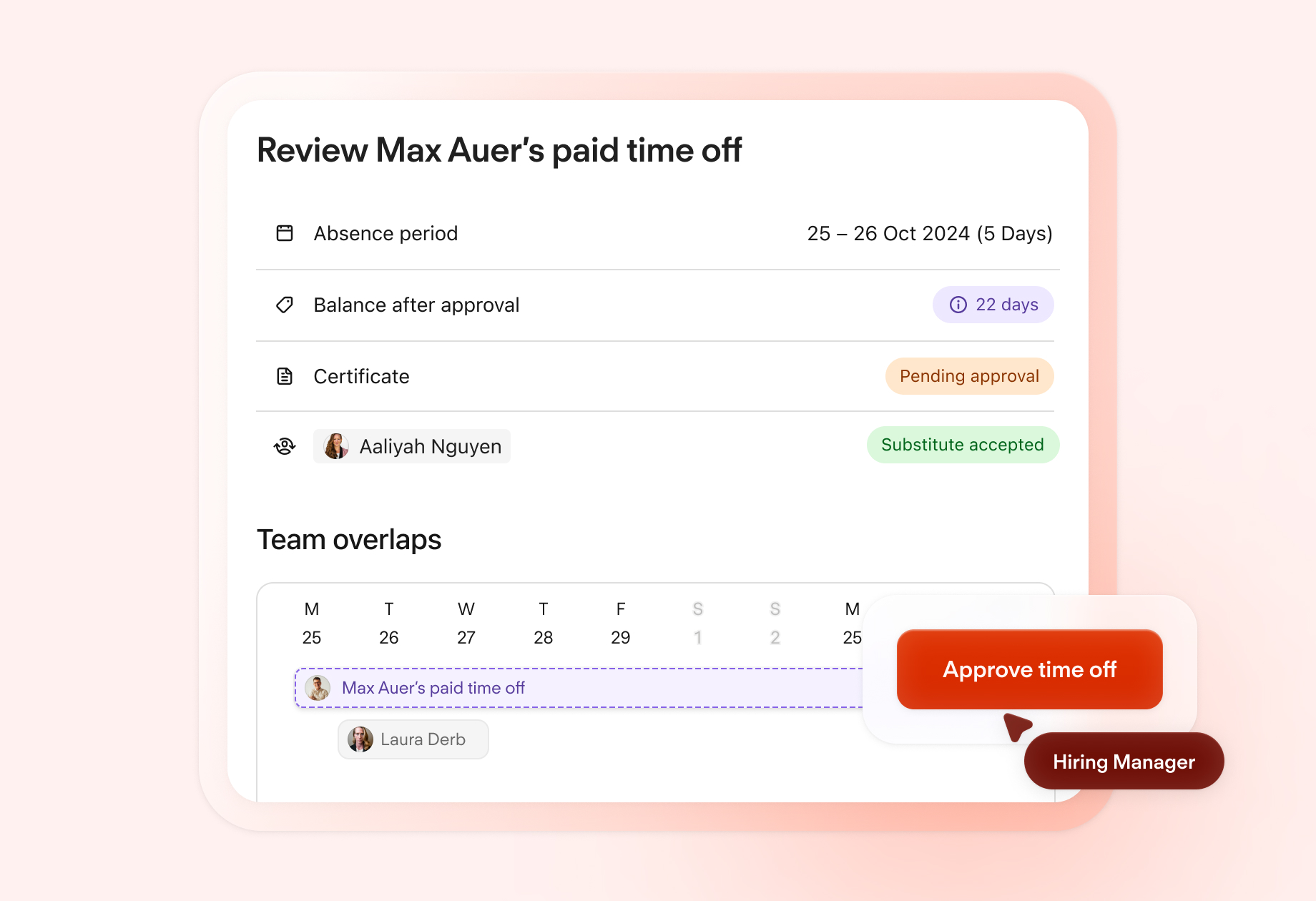Latest Blog Posts
Preventing Presenteeism in the Workplace

Is presenteeism, or a culture of it, holding back the productivity of your organization? In this blog, we cover the essentials on this topic. What presenteeism is exactly, why it is so common, the signs your People Team should look out for, and more.
Get started by downloading our free guide to developing a lasting corporate culture.Contents
- 1What Is Presenteeism?
- 2Is Presenteeism Good Or Bad?
- 3What Is The True Cost Of Presenteeism?
- 4Who’s More Likely To Suffer From Presenteeism And What Causes It?
- 5Does Presenteeism Apply When People Are Working From Home?
- 6What Is The Difference Between Presenteeism And Absenteeism?
- 7How Do You Identify Presenteeism In The Workplace?
- 8What Can You Do To Stop Presenteeism?
- 9Put An End To Presenteeism Today
What Is Presenteeism?
Presenteeism is being at work without being productive. This is typically because employees feel the need to come in when they are old or should otherwise not be working. When an employee is expected to come in, even when they are sick, this is a culture of presenteeism.
Is Presenteeism Common?
It’s more common than you think, and it is growing! According to the Chartered Institute of Personnel and Development (CIPD), presenteeism more than tripled between 2010 and 2018!
Click here to watch our latest HR Expert Interview with the CIPD’s Hayfa Mohdzaini.
Why Is Presenteeism So Common?
The higher pressure a work environment is, the more likely employees are to feel that they must be seen to be busy. This results in overwork. Companies who set unrealistic deadlines, expect too much of employees, or require too high a workload from staff are likely to set a precedent for presenteeism.
It is, indeed, more common in white-collar organizations and particularly in legal firms, according to the financial review, since junior staff members are treated as commodities and expectations are unrealistic. But it doesn’t only happen there. Presenteeism is a curse that can affect any and all businesses: Yours included!
Is Presenteeism Good Or Bad?
While it might not seem like a big deal to work through a cold – especially if you’re frantically trying to meet a deadline or it’s just a little sniffle. In fact, HR Magazine says that presenteeism isn’t necessarily a bad thing. But there’s a big difference between functional presenteeism and dysfunctional presenteeism.
Let’s break each down for you:
Functional Presenteeism – This is a more sustainable version of presenteeism, wherein an employee may be working to finish something on deadline, even if they are not 100%. That said, this is not because they feel forced and they also have access to all of the support they would need otherwise from their employer.
Dysfunctional Presenteeism – We can think of this as a more toxic or unsustainable version of presenteeism when it comes at the expense of an employee’s health or puts their overall productivity at risk.
If functional presenteeism exists, it is an employer’s duty to know how to make sure employees feel supported so they don’t burn the candle at both ends. If dysfunctional presenteeism exists, though, it is on employers to put a stop to it (for the benefit of productivity).
Speaking of benefits, let’s think about the true costs of presenteeism…
What Is The True Cost Of Presenteeism?
Dysfunctional presenteeism isn’t just bad for employees, it’s bad for business. Presenteeism can:
Make other employees sick by passing on germs and infections.
Cause, rather than relieve stress (especially if it goes on for too long).
Create mental health issues.
Result in burnout and loss of productivity over the longer term.
Cause increased errors.
Result in increased staff turnover.
Ultimately, it may be tempting for organizations to overlook presenteeism in the hopes of simply "getting things done." That said, it’s not sustainable.
In the long term, employees who have worked too hard for too long won’t just be more likely to leave the business, they’ll also be more likely to resent the company, their jobs, and even the very nature of their work.
It’s a chronic condition. When it’s not stopped, it causes a lot of harm to people, to businesses, and even to the company’s long-term reputation.
Free Download: The Costs Of Doing Nothing In HR

Many HR departments have hidden costs that take away time and productivity from more important, people-focused projects. Download our guide to discover them for yourself.
Download NowWho’s More Likely To Suffer From Presenteeism And What Causes It?
According to an institute for employment studies (ies) report, presenteeism is often a common condition with:
Workaholics
People with financial problems
Managers who feel they have to set an example
People with depression
People with unhealthy lifestyles (who don’t exercise much or have unhealthy diets)
Older workers
Insomniacs
But, what actually causes it?
Presenteeism usually results from a combination of factors including, but not limited to – unrealistic employer expectations, loyalty or job insecurity, large workloads, understaffing, excessive time pressure, and a culture where being sick is not socially acceptable.
In its extreme form, presenteeism can actually be a result of organizational harassment or discrimination which forces employees to avoid taking sick days.
Does Presenteeism Apply When People Are Working From Home?
Absolutely! People might not have to struggle to get out of bed, shower, get dressed, travel, and make their way into the office when they’re sick these days, thanks to remote working, but that doesn’t mean they’re not showing signs of presenteeism!
If you’re sick, you’re sick. That doesn’t mean you should be at your desk with your camera off: It means you should be in bed, logged off, resting, and most of all, recovering!
(Incidentally – some believe that remote working may be coming to an end as vaccine rollouts gain increasing momentum. If you’re curious to find out more, read our blog post on Remote Working: Here To Stay Or On Its Way Out?)
Free Resource: Employee Survey Template
Do you know how your employees are feeling? Would you like to? Download our free employee survey today to gain helpful insights into the ‘mood’ of your organization.
Download NowWhat Is The Difference Between Presenteeism And Absenteeism?
In a way, presenteeism is the opposite of absenteeism. As we explain in our article on managing the eight key causes of absenteeism, absenteeism is when an employee consistently doesn’t appear for work at their scheduled time or takes excessive time off.
Employees are also considered to show signs of absenteeism if:
They take time off work for suspicious reasons or use flimsy excuses,
Exceed their allocated leave allowance and sick leave allowance, or use it up right at the beginning of the leave year, or if they
Start missing work at regular intervals (for example, every time the month-end reports are required, on a Monday morning or just before an important project is due).
Ironically, while the symptoms are opposite in their approach – employees who show signs of staying too long at work demonstrate presenteeism, those who stay away from work too much show signs of absenteeism – the root causes may be the same.
These can include mental health issues, family issues, community issues, challenges with a team member or manager, and illness.
How Do You Identify Presenteeism In The Workplace?
It’s relatively easy to tell when an employee is not at work. Or, at least, it was in the days when we worked from the office. However, it’s harder to detect presenteeism. As a general rule of thumb, staff members who suffer from presenteeism will:
Come in to work when they’re sick
Play down an illness
Work extremely long hours – beyond their contracted hours
Come in early or stay late – regardless of their workload.
When an employee takes these actions it may be a very loud and clear warning sign that something is wrong – either at work or at home. Then it’s time to check on their motivation levels and see if you can step in before things get too bad.
The challenge is that it’s not always easy to tell when an employee is simply doing their job, or when they’re working excessively. It’s even harder when teams are working remotely, when employees don’t have open lines of communication with their managers or when people hide it, deliberately.
Can You Measure Presenteeism?
In short, no. At least, not easily. It’s much harder to identify presenteeism than absenteeism.
But there are warning signs (as we describe above). Often, recognizing presenteeism is a skill that requires good leaders and managers to identify and stop before it gets out of hand. Once the signals that an employee is likely to suffer from presenteeism have been identified, though, it’s important to track it – like any other HR issue.
What Can You Do To Stop Presenteeism?
Stopping presenteeism is all about creating the right culture. If your employees know it’s okay to take a day off when they’re sick, they won’t turn up at work just to ‘show their face.’
If they are actively discouraged from working when they’re sick, even better. Here are a few ways you can help stop presenteeism:
Have An Absence Management Policy
A great place to begin is by creating a policy that states when employees are expected to work and when it’s important that they do not work!
A policy like this should state how your company reports on and records absences, when employees need to provide evidence of illness, what sick pay they’re entitled to, and what happens if they’re off work for a long period of sick leave.
Click here to learn more about Personio’s absence management software today.
(Don’t forget that in the UK, Statutory Sick Pay is legal and mandatory after employees have been ill for at least four days in a row (including weekends).
Flexible Working Hours
Sometimes employees work longer hours because they have taken breaks in between their day – for example, to take kids to school.
If you allow flexible working hours it might actually reduce the instance of presenteeism, as long as both employer and employee know what is expected of them, and when it’s okay to be flexible.
Offer Enough Time Off
It isn’t just good sense to give employees enough paid time off to help them cope with the stresses and strains that we all experience at times during our working lives, it’s actually a legal requirement.
In the UK, most workers who work five-day workweeks are legally entitled to 28 days of paid holiday per year or 5.6 weeks. Employees can also offer different kinds of leave, including time off in lieu (TOIL), sabbaticals, and unpaid leave.
How do you go about building a paid time off policy? Here’s how we’d recommend doing it.
Provide Enough Sick Leave
It’s just good business sense. It’s also the law in the UK to provide statutory sick pay.
Collate and Share Mental Wellbeing Resources
There is so much helpful information available about mental wellbeing these days! You can even start by reading our guide to mental health in the workplace right here.
Training
It’s important to recognize the issue of presenteeism and prevent it from creating a toxic culture in your company. Training managers to recognize the signs and take steps to address them before a few instances become a toxic pattern, will serve your employees well.
It will also serve as a credit to your company and the compassion you can show to your employees when times are tough.
Staff Surveys
How are your employees doing, really? Do you know? Have you asked?
If so, have you asked them recently? Employee or staff surveys are a really good way of keeping a finger on the pulse of the organization’s wellbeing and understanding how employees are really doing.
You’re never too big or too small to check on your employees. But if you need a bit of help to get started, we’ve provided a free employee survey template to download.
Communicate
Lastly, to overcome presenteeism, make openness and honesty a key part of your corporate culture.
If employees feel comfortable enough with their managers to tell them when things are tough at home – or in any other context that could affect their work – the chances are that you can resolve issues sooner.
That doesn’t just help you give them the support they need now, or in the future, it also helps you identify issues before they become bigger business issues.
Put An End To Presenteeism Today
Presenteeism is a growing issue in the office and remotely, but it doesn’t have to be. If you have the proper processes in place, and the right software to serve as a helpful foundation, everything can go much more smoothly. Click here to learn more about Personio’s HR software.


